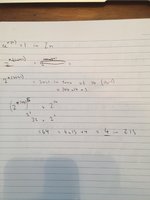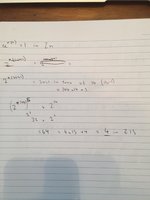You are using an out of date browser. It may not display this or other websites correctly.
You should upgrade or use an alternative browser.
You should upgrade or use an alternative browser.
Not sure where to start (totients?)
- Thread starter Leo79
- Start date
AmandasMathHelp
New member
- Joined
- Feb 9, 2021
- Messages
- 35
The first thing you have to understand is that the totient identifies that number of numbers (less than the number) that are relatively prime/coprime with the number. Basically all the numbers less than a number that DO NOT share any factors with that number. So the first question is pretty simple because obviously if the number is prime than by definition almost none of the numbers under it will share factors with it. So most of them are included in the totient. Just explain why exactly n-1 numbers are included in the totient.
The second one is not so easy. Do you have any more specific questions about it?
The second one is not so easy. Do you have any more specific questions about it?
Oh Okay - So my answer for 3a is:
Since p is a prime number, the only possible values of are 1 and p. The only way to have is if n is a multiple of p. There is only 1 multiple less than p. Therefore, the other p-1 numbers are all relatively prime to p. Hence, if and p is prime: φ(p)=p−1
I'm familiar with Fermat's theorem, although I'm a bit confused with how it translates in 3b - could I please have help with this? Is what I've put below on the right track?

Since p is a prime number, the only possible values of are 1 and p. The only way to have is if n is a multiple of p. There is only 1 multiple less than p. Therefore, the other p-1 numbers are all relatively prime to p. Hence, if and p is prime: φ(p)=p−1
I'm familiar with Fermat's theorem, although I'm a bit confused with how it translates in 3b - could I please have help with this? Is what I've put below on the right track?

Oh Okay - So my answer for 3a is:The first thing you have to understand is that the totient identifies that number of numbers (less than the number) that are relatively prime/coprime with the number. Basically all the numbers less than a number that DO NOT share any factors with that number. So the first question is pretty simple because obviously if the number is prime than by definition almost none of the numbers under it will share factors with it. So most of them are included in the totient. Just explain why exactly n-1 numbers are included in the totient.
The second one is not so easy. Do you have any more specific questions about it?
Since p is a prime number, the only possible values of are 1 and p. The only way to have is if n is a multiple of p. There is only 1 multiple less than p. Therefore, the other p-1 numbers are all relatively prime to p. Hence, if and p is prime: φ(p)=p−1
I'm familiar with Fermat's theorem, although I'm a bit confused with how it translates in 3b - could I please have help with this? Is what I've put below on the right track?

AmandasMathHelp
New member
- Joined
- Feb 9, 2021
- Messages
- 35
Yes, it might help your answer for part a to say specifically that the one factor the prime number isn't coprime with is its self. gcd(n,n)=n. I'm really not sure how to do that second question because it wants 2^2021 and not 2^(totient of 2021). So I am thinking how can you even use that rule? Is 2021 the totient of another larger number you need to look at? You would think maybe a prime number because the totient of a prime number is easy... but 2022 is not prime. So I am not sure. Anyone else got ideas?

